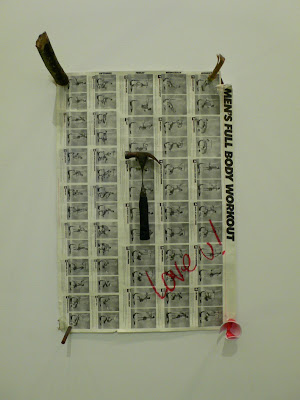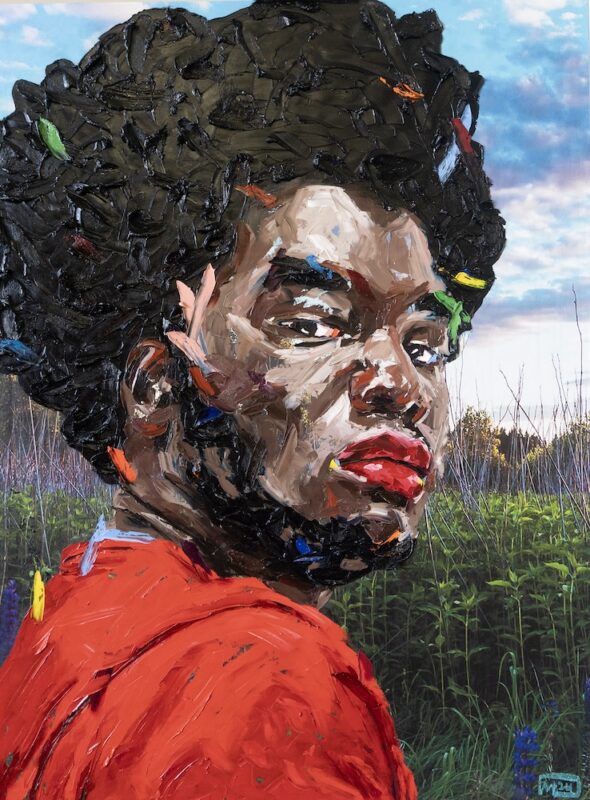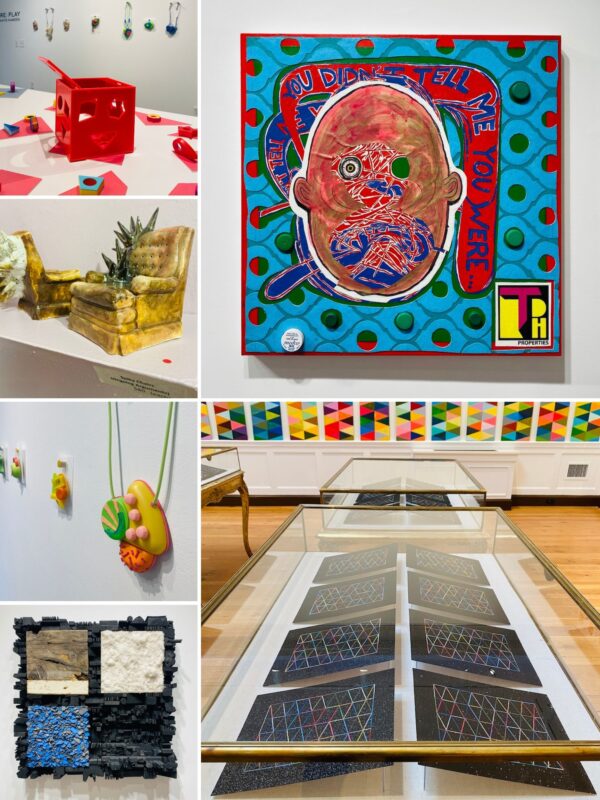
Sondheim Artscape Prize: 2010 Finalists
June 19 – August 1, 2010
Free exhibition
In conjunction with Artscape, Baltimore’s premier arts festival organized by the Baltimore Office of Promotion & The Arts, the BMA presents a special exhibition of works by the finalists for the Janet & Walter Sondheim Artscape Prize. This year’s finalists are: Leah Cooper, Ryan Hackett, Matthew Janson, Nate Larson, Christopher LaVoie, Matthew Porterfield, and Karen Yasinsky.
The semi-finalists, finalists, and winner are all chosen by an independent panel of jurors. This year’s jurors are: Robert Nickas, an independent New York-based curator, writer and art critic; Magdalena Sawon, owner and director of New York’s Postmasters Gallery; and Hamza Walker, director of education and associate curator of the Renaissance Society at The University of Chicago. The finalists were announced on April 13. The winner of the $25,000 prize will be announced on July 10. Artscape is held July 16-19, 2010.

Sculptural Works by Christopher LaVoie
First of all, I have to say that it is difficult to arrive at this exhibit with an open mind. I have seen all of these artist’s works before, in other exhibits, including last year’s Sondheim Prize finalist show, and I have strong opinions about all of them. I know many of these artists personally or professionally, and this also makes it difficult to be an objective and honest critic. In general, all seven artists have risen to the occasion, are playing their game at a heightened level, and are good and deserving candidates for this year’s prize. However, it is difficult to see these works fresh, without any preconceived notions, based on past projects, past exhibits, and past press.
 Christopher LaVoie is the first artist you encounter when you enter the Sondheim Exhibt, and I found him to be a complete surprise. While many of LaVoie’s sculptures have a mundane, and even boring, appearance, closer inspection reveals a delightful range of unexpected and subtle twists. In ‘Folked Drumsticks’ (pictured above) a found, forked tree branch is carved at the end into drumsticks, which are polished with bronze. In ‘Lumber Crying,’ (pictured below), an ordinary piece of milled lumber appears to have tiny droplets coursing down it’s side, somehow carved out of the same wood. It’s subtle, but thrilling to discover.
Christopher LaVoie is the first artist you encounter when you enter the Sondheim Exhibt, and I found him to be a complete surprise. While many of LaVoie’s sculptures have a mundane, and even boring, appearance, closer inspection reveals a delightful range of unexpected and subtle twists. In ‘Folked Drumsticks’ (pictured above) a found, forked tree branch is carved at the end into drumsticks, which are polished with bronze. In ‘Lumber Crying,’ (pictured below), an ordinary piece of milled lumber appears to have tiny droplets coursing down it’s side, somehow carved out of the same wood. It’s subtle, but thrilling to discover.

According to his artist statement, LaVoie uses everyday objects and experiences related with masculinity, as well as the theme of domesticating the more menacing aspects of human behavior and the natural world. The artist also has a keen interest in the natural properties of common materials, paying attention to their inherent physical qualities and teasing out these characteristics.
The other piece included in the photo above is called ‘Sediment Hatchet’ and is made from sediment collected from the bottom of a shop sink, mixed with a binding agent, and cast into it’s current shape. This is the work I have been more accustomed to from LaVoie – unusual materials cast into the shapes of tools and masculine objects. The other vitrine contains ‘Concrete Mickey Slippers’ (exactly what they are titled) and cast dumbbells made from pureed OK Computer CD’s. While it might seem a random choice, (heavy metal seems more macho, right?) Radiohead’s OK Computer is seen by many critics to be a masterpiece and deals with issues of consumerism, discontent with the modern world, and a sense of loss. LaVoie’s dumbbells might just be the ultimate symbol of the thinking and sensitive man’s modern dilemma: a choice between extremes in becoming an individual. In LaVoie’s world, traditional masculinity is a trap, but emo doesn’t seem to be a particularly appealing or authentic choice, either.


LaVoie’s largest piece appears to be a replica of an ancient mastaba on two sides, but it’s intense green lights projected from below transform it into a space ship or odd appliance. Titled ‘Energy temple,’ this piece is interactive. If you touch the triangle copper plate at the top, a low vibration emanates from it’s speakers. The more the hands that participate, the louder the sound. I haven’t figured out how this piece relates to the others, but, based on sheer size and slickness, it demands the lion’s share of your attention in this space.
Like the rest of LaVoie’s oevre, this sculpture is clever, well-crafted, and exudes a sense of confidence. None of these pieces appear to be trying too hard, which is appealing. All of the people I discussed the Sondheim show with agreed: LaVoie is our pick for the prize. This probably means he won’t get it, but he should.

Photographs by Nate Larson
I will admit I am a sucker for image and text. And who doesn’t love the arcane phrases and poetry which sometimes sprout from Twitter’s 140-letter limit? They’re like little Haikus, mined from the belly of a collective consciousness, full of pithy humor, personal revelations, and odd twists. I wish I had thought of this first.
The artist adds a conceptual framework to the project by using the “geotag” information embedded in tweets to discover where each post was made. The artist travels to the location, wherever it is, and uses a documentary style to photograph the place. These photos are then paired with the original exclamations and illuminate a range of human emotions, elevating private musings, mis-spellings and all, to poetic visions.

Larson’s tweet-o-graphs are catchy and satisfying. You relate to them immediately and you GET it. The photographs are beautiful. The framing is elegant and simple. The size of the prints is consistent, although they might be more powerful at a larger scale. The photos are neat and fun. This is also their problem. It’s too neat and too fun. After I walked around the gallery, looking and reading, and chuckling to myself, I had no more questions. This project was tightly conceived and executed. There are no loopholes. I don’t feel angry at this artist or confused or surprised. And I want to.


Nate Larson discusses his work.
I am not sure what to say here, as Porterfield issued a preemptive apology about his work: it’s not done and the video piece below was going to be replaced. On Friday, I did not have time to sit down and watch ‘Hamilton’ in it’s approximately one hour entirety, so at best I did a quick scan of the two dark rooms, and moved on. In the context of an art museum, ‘Hamilton’s’ quiet and painterly visions seemed to question the boundaries between artist and filmmaker, between painting and film. His characters are not movie star gorgeous, but his subtle side lighting bathes them in a glow and quietude not unlike a Vermeer.
One may question what Porterfield is doing at the BMA, after conquering at indie film festivals and getting rave reviews across the country. According to The New Yorker Magazine, Porterfield is a genius and ‘Hamilton’ is “exquisitely composed, unfolding gradually, suffused with light and color,” and “his tender yet unsentimental images convey the graceful rhythms and quiet sorrows of young lives on hold.” This kind of acclaim doesn’t get much better, especially for an artist still in his 20’s.
As an art museum audience, we have a lack of film context, so we have to resort to experiencing Porterfield’s films from an art perspective. As the walls between film, animation, video, and narrative art continue to collapse, and artist-filmmakers and filmmaker-artists are allowed to exist in between these worlds, watching a feature-length film in an art gallery will probably become more and more common. The BMA is air-conditioned and free, so who knows? Maybe I will head back over and watch the whole film, sans the popcorn. The BMA should probably include more seating in this case.
Matthew Janson’s works are creepy and beautiful, employing a David Altmejd-esque aesthetic of the grotesque, the theatrical, and the extreme. Wall pieces as well as 3-D are equally odd and embellished – with broken mirrors, bits of furniture, wild color, and found objects. When you enter the room, Janson’s larger-than-a-person mirrored scultpures sparkle like a giant, mangled disco ball, and as you walk around it, you wonder why it has wheels on it’s side.
There is a lot of hooplah and ornate frou-frou going on here, and I’m not sure where it is all going. The artist certainly knows how to combine disparate materials together in surprising and physically moving ways, but there’s also something empty and ornate about this, a big wow factor without specificity to back it up.
According to the BMA, Janson’s hybrids employ “a tension between light-heartedness and menace,” which is best realized in his most absurd works. ‘Parlor Rat’, (pictured below) is a combination of upholstered furniture, broken mirrors, and some other goop ( I don’t know what else went into it, because the artist described all his pieces as ‘mixed media, which is really annoying) and, in it’s absurdity, approaches an interesting balance of creature, furniture, and garbage pile, and seems animated.
This artist has a lot of heart and energy, I just think the work is all over the place. I’d like to see what Janson is doing in a few years, especially if he is able to choose one line of inquiry and stick to it.

The artist answers questions from a journalist.

Ryan Hackett, with his large whale-inspired paintings.

Ryan Hackett was one of last year’s Sondheim finalists and I was in love with his sculptural installation of oddly distilled animal essences. This makes it tough for me to be objective about this new body of work. Last year’s offering was seamless and strong, and definitely difficult to top. In Hackett’s own words, “The most ambitious move I could make this year was to take a step backwards, to painting, which is where my art originated.” You have to respect an artist who doesn’t play it safe and is willing to take risks, even when he reverts back to a more traditional, less contemporary media.
Hackett’s area is sparse; there are two giant paintings, each exactly as tall as the artist, which use only tones of blue and gray to depict abstracted images of whales. There is a video projection booth located around the corner, which echoes Hackett’s whale theme in sound and color. I think Hackett’s room would feel more integrated and complete without the separate room for the video – all three pieces, sounds included, would benefit from one continuous horizontal view, and would immerse the viewer more effectively.
Despite their subtlety and quiet, Hackett’s work still manages to distill the essence of the natural world and translate it into something modern and oddly artificial. Despite a huge change in media and attitude, Hackett’s themes remain consistent and thoughtful. Like LaVoie, Hackett is pushing the ‘less is more’ envelope, a calculated risk.


Video Projection by Ryan Hackett

Artist Leah Cooper in her architectural installation

Leah Cooper is a young artist who has gracefully stepped up to the plate, without altering her unique vision. Cooper employs a consistent and inquisitive way of seeing, then excises the small details from mundane architecture, intellectualizing it in the process. If you saw her two-person show at the Theatre Project this spring, you will remember those same mirrors, architectural pencil lines, and neutral lines of tape. While effective in that space, a larger gallery with taller ceilings might benefit from larger mirrors and an adjusted scale or intensity of line.
Part of Cooper’s mission is to push intellectual buttons and question the way we see ordinary objects and scenes. How subtle can subtle be? How simple can a drawing be? What are the aesthetic rewards inherent in architectural decisions based on efficiency and logistics? Are these the concerns of architects only, or can regular viewers appreciate these questions? As a result, it’s easy for a viewer to miss most of her drawing and iterations. Cooper’s work definitely requires a slow read, and does leave an engaged viewer with many questions.

This year, Karen Yasinsky has scaled it down, big-time, like Ryan Hackett. She is a three-time Sondheim Finalist, and this year was also the recipient of a $25,000 Baker Artist Award and the intensely competitive Prix de Rome, which allows for a year of art-making in Bella Roma. Her pared-down confidence makes you wonder if this will be Yasinsky’s year for a triple-crown, or if she is just tired of all these competitions.
This year, Yasinsky has chosen not to display any drawings or longer films, instead, to project one hand-drawn animation on a 2:50 minute loop. The piece benefits from a large, insular viewing room and being projected huge – from floor to ceiling. Like other Yasinsky films, ‘You have to be very careful’ is created by appropriating sequences from movies and translating them into her own style of drawing.
According to the BMA, Karen Yasinsky investigates how visual composition, editing, color, and sound creates emotional and psychological effects. To me, this sounds more purposeful and exact than the puzzling and open-ended narratives that Yasinsky builds. In this particular piece, Yasinsky traced several sections of Robert Altman films – California Split and Thieves Like Us – and she seems to be more interested in showing us her own ambiguous feelings or memories about these films, rather than a literal or thematic translation of them. Elliot Gould and Shelly Duvall are the two characters Yasinsky chose to draw and one isn’t sure if they are fighting, ignoring one another, or peacefully co-existing, with a montage of 1970’s processed food products at the end.
‘You have to be very careful’ is entertaining because of the artist’s playful gestures, as well as her animation style, which is a mix of high and low aesthetics, but it seems disjointed. Gould, Duvall, and the canned food don’t interact – they just happen to be in a short animated film together. In this way, the piece comes off as a sketch or musing, rather than a complete vision.
For current, behind-the-scenes pictures of the installation and exhibit, visit the BMA’s
Flickr stream.
Christopher LaVoie is the first artist you encounter when you enter the Sondheim Exhibt, and I found him to be a complete surprise. While many of LaVoie’s sculptures have a mundane, and even boring, appearance, closer inspection reveals a delightful range of unexpected and subtle twists. In ‘Folked Drumsticks’ (pictured above) a found, forked tree branch is carved at the end into drumsticks, which are polished with bronze. In ‘Lumber Crying,’ (pictured below), an ordinary piece of milled lumber appears to have tiny droplets coursing down it’s side, somehow carved out of the same wood. It’s subtle, but thrilling to discover.



